publications
publications by categories in reversed chronological order. generated by jekyll-scholar.
2025
-
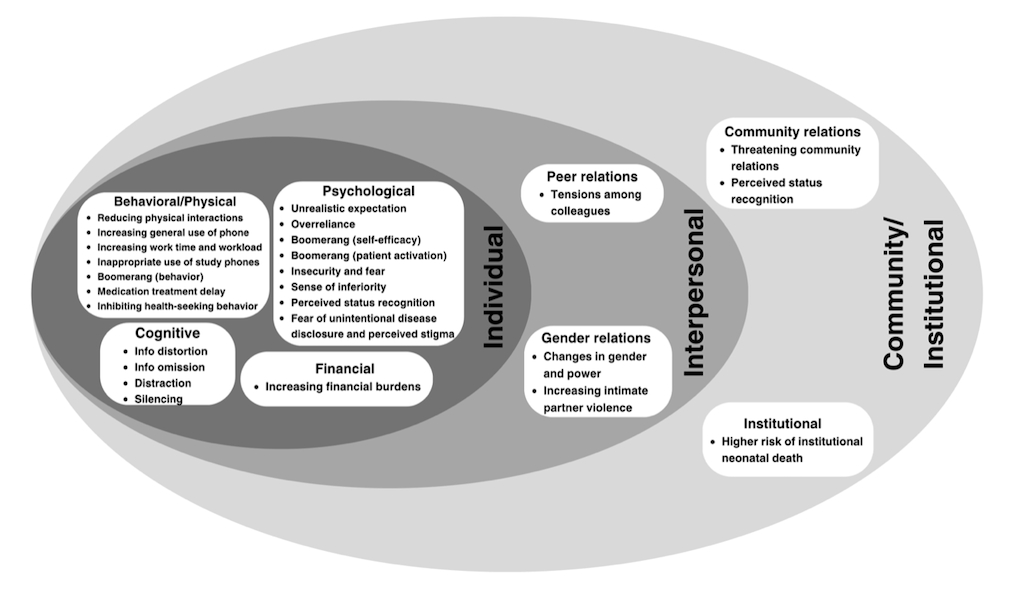 Planning for the Unexpected and Unintended Effects of mHealth Interventions: Systematic ReviewWeidan Cao, Xiaohui Cao, and Andrew David Sutherland2025
Planning for the Unexpected and Unintended Effects of mHealth Interventions: Systematic ReviewWeidan Cao, Xiaohui Cao, and Andrew David Sutherland2025Background: mHealth interventions can produce both intended and unintended effects. Examining these unintended effects helps to create a more complete and objective understanding of mHealth interventions and can reduce potential harm to participants. Existing studies on the unintended effects, which were published several years ago, tend to have either a general focus on health information technology or a specific focus on healthcare providers, thereby excluding other key stakeholders (e.g., patients, community health workers). Additionally, these studies did not systematically outline the causes of the unintended effects or strategies for their prevention. Objective: To address this gap, this systematic review, guided by the ecological framework, aims to systematically identify the unintended effects of mHealth interventions, create a typology for them, investigate the reasons for their occurrence, describe how they were detected, and propose ways to prevent or lessen them. Methods: Following the Preferred Reporting Items for Systematic Review and Meta-Analyses (PRISMA) guidelines, a systematic review was performed to examine the unintended effects of health interventions that use mobile technology. Results: A total of 15 articles were included in the review. An ecological typology of mHealth Unintended Effects (mHUE) was developed, which includes 26 distinct effects (e.g., silencing and boomerang). The majority of these unintended effects (n = 20) occur at the individual level and span physical/behavioral (n = 7), psychological (n = 8), cognitive (n = 4), and financial (n = 1) domains. Three effects occur at the interpersonal level, and another three at the community/institutional level. Most of the identified effects (n = 22) were negative. Potential causes for these effects include the improper use of mHealth technology, poorly designed interventions, the application of unsuitable intervention mechanisms, or a misalignment between the untended outcomes and the socio-cultural context. Strategies and recommendations (e.g., considering the context such as cultural norms) were suggested to help prevent or reduce the unintended effects. Conclusions: The unintended effects detailed in the mHUE typology were heterogenous and context dependent. These effects can influence individuals across different domains, and also affect unintended people within the ecological system. As most of the unintended effects are negative, if they are not monitored, mHealth interventions designed to empower participants could paradoxically disempower them (e.g., decreasing self-efficacy for disease management, undermining patient control and engagement). The mHUE typology, together with the proposed recommendations and strategies, can be used as a guide to enhance the planning, design, implementation, and post-implementation evaluation on mHealth interventions. Future research should concentrate on understanding the specific mechanisms behind these unintended effects.
-
 WatchGuardian: Enabling User-Defined Personalized Just-in-Time Intervention on SmartwatchYing Lei, Yancheng Cao, Will Wang, and 13 more authors2025
WatchGuardian: Enabling User-Defined Personalized Just-in-Time Intervention on SmartwatchYing Lei, Yancheng Cao, Will Wang, and 13 more authors2025While just-in-time interventions (JITIs) have effectively targeted common health behaviors, individuals often have unique needs to intervene in personal undesirable actions that can negatively affect physical, mental, and social well-being. We present WatchGuardian, a smartwatch-based JITI system that empowers users to define custom interventions for these personal actions with a small number of samples. For the model to detect new actions based on limited new data samples, we developed a few-shot learning pipeline that finetuned a pre-trained inertial measurement unit (IMU) model on public hand-gesture datasets. We then designed a data augmentation and synthesis process to train additional classification layers for customization. Our offline evaluation with 26 participants showed that with three, five, and ten examples, our approach achieved an average accuracy of 76.8%, 84.7%, and 87.7%, and an F1 score of 74.8%, 84.2%, and 87.2% We then conducted a four-hour intervention study to compare WatchGuardian against a rule-based intervention. Our results demonstrated that our system led to a significant reduction by 64.0 +- 22.6% in undesirable actions, substantially outperforming the baseline by 29.0%. Our findings underscore the effectiveness of a customizable, AI-driven JITI system for individuals in need of behavioral intervention in personal undesirable actions. We envision that our work can inspire broader applications of user-defined personalized intervention with advanced AI solutions.
-
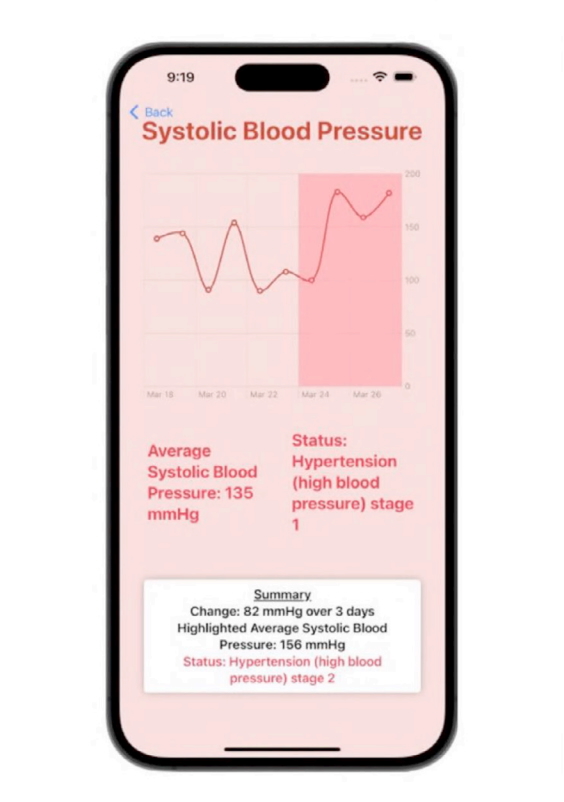 QUALITY AND READABILITY OF CHATGPT IN ANSWERING PATIENTS’ PREVENTIVE CARDIOLOGY QUESTIONS: A PILOT STUDYPrem Patel, Allison Bigeh, Benjamin Romer, and 5 more authors2025
QUALITY AND READABILITY OF CHATGPT IN ANSWERING PATIENTS’ PREVENTIVE CARDIOLOGY QUESTIONS: A PILOT STUDYPrem Patel, Allison Bigeh, Benjamin Romer, and 5 more authors2025Therapeutic Area Other Background As artificial intelligence (AI) becomes increasingly integrated into healthcare, ChatGPT has emerged as a promising tool for patient education. However, research on its suitability for preventive cardiology remains limited. With patients increasingly relying on online health information, it is essential that content is both scientifically accurate and accessible to individuals of all health literacy levels. This study evaluates the quality and readability of ChatGPT’s responses to common questions on lifestyle modification, women’s cardiovascular health, and cholesterol management. Methods Twenty-six questions (8 on lifestyle modifications, 8 on women’s cardiovascular health, and 10 on cholesterol management) were queried using the GPT-4 model. Responses were independently evaluated by three board-certified preventive cardiologists, referencing the latest national cardiovascular guidelines. Quality was assessed using a 5-point Likert scale for correctness, comprehensiveness, conciseness, and comprehensibility, previously employed in medical AI research. Readability was analyzed using the Flesch-Kincaid Grade Level and other standardized readability metrics. Results ChatGPT provided adequate responses to 88.4% (23/26) of questions, with mean (SE) scores of 3.71 ± 0.20 for correctness, 4.06 ± 0.14 for conciseness, 4.06 ± 0.13 for comprehensiveness, and 4.40 ± 0.10 for comprehensibility. The highest-scoring topic was lifestyle modification (84.4%), followed by cholesterol management (81.2%) and women’s cardiovascular health (77.8%). Among inadequate responses, key limitations included overstating the risks of low LDL cholesterol and exaggerating the benefits of estrogen replacement therapy (ERT) for postmenopausal CVD risk reduction. ChatGPT also provided unsupported recommendations regarding dietary supplements for CVD prevention. Readability analysis revealed responses at a 13th-grade level, exceeding the recommended 6th-grade level for patient education. Conclusions ChatGPT’s responses were generally suitable for topics such as heart-healthy diets, exercise, weight management, epidemiology and clinical presentation of CVD in women, postmenopausal CVD risk, cholesterol-lowering therapy, statin-associated side effects, and Lp(a) risk stratification. However, inaccuracies persisted in dietary supplementation, ERT, and very low LDL levels. Enhancements in AI training are needed to improve accuracy in these areas. Additionally, the high readability level limits accessibility for the general public, underscoring the need for optimization to ensure clear and reliable patient education.
-
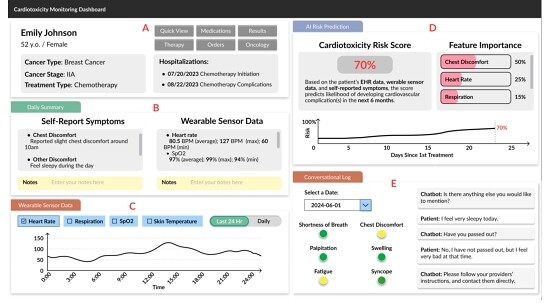 CardioAI: A Multimodal AI-based System to Support Symptom Monitoring and Risk Prediction of Cancer Treatment-Induced CardiotoxicitySiyi Wu, Weidan Cao, Shihan Fu, and 7 more authorsIn Proceedings of the 2025 CHI Conference on Human Factors in Computing Systems, Yokohama Japan, 2025
CardioAI: A Multimodal AI-based System to Support Symptom Monitoring and Risk Prediction of Cancer Treatment-Induced CardiotoxicitySiyi Wu, Weidan Cao, Shihan Fu, and 7 more authorsIn Proceedings of the 2025 CHI Conference on Human Factors in Computing Systems, Yokohama Japan, 2025 -
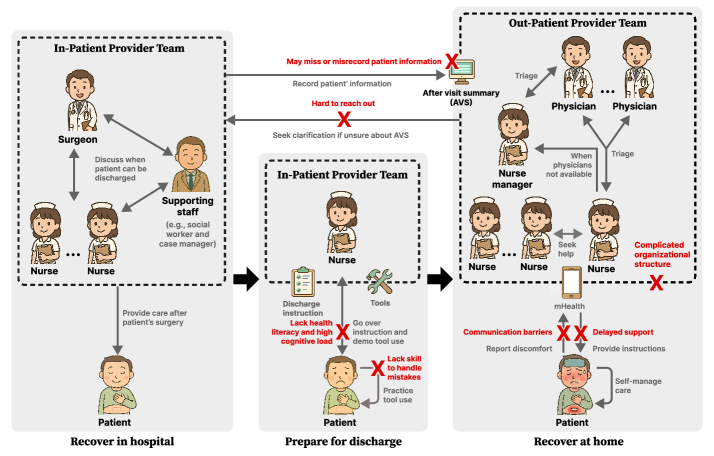 Exploring Collaboration Breakdowns Between Provider Teams and Patients in Post-Surgery CareBingsheng Yao, Menglin Zhao, Zhan Zhang, and 11 more authors2025
Exploring Collaboration Breakdowns Between Provider Teams and Patients in Post-Surgery CareBingsheng Yao, Menglin Zhao, Zhan Zhang, and 11 more authors2025Post-surgery care involves ongoing collaboration between provider teams and patients, which starts from post-surgery hospitalization through home recovery after discharge. While prior HCI research has primarily examined patients’ challenges at home, less is known about how provider teams coordinate discharge preparation and care handoffs, and how breakdowns in communication and care pathways may affect patient recovery. To investigate this gap, we conducted semi-structured interviews with 13 healthcare providers and 4 patients in the context of gastrointestinal (GI) surgery. We found coordination boundaries between in- and out-patient teams, coupled with complex organizational structures within teams, impeded the "invisible work" of preparing patients’ home care plans and triaging patient information. For patients, these breakdowns resulted in inadequate preparation for home transition and fragmented self-collected data, both of which undermine timely clinical decision-making. Based on these findings, we outline design opportunities to formalize task ownership and handoffs, contextualize co-temporal signals, and align care plans with home resources.
-
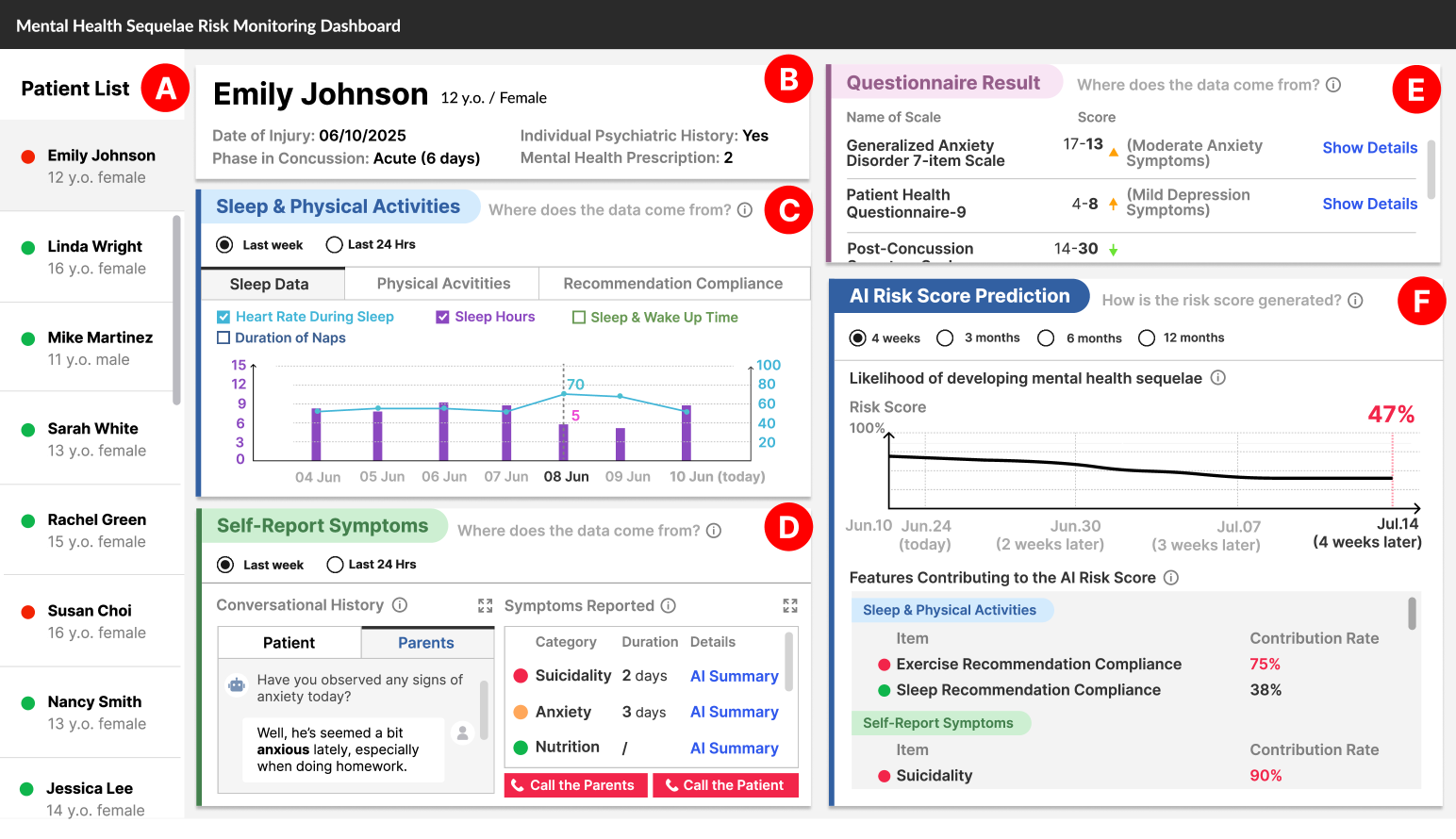 More Modality, More AI: Exploring Design Opportunities of AI-Based Multi-modal Remote Monitoring Technologies for Early Detection of Mental Health Sequelae in Youth Concussion PatientsBingsheng Yao, Menglin Zhao, Yuling Sun, and 7 more authors2025
More Modality, More AI: Exploring Design Opportunities of AI-Based Multi-modal Remote Monitoring Technologies for Early Detection of Mental Health Sequelae in Youth Concussion PatientsBingsheng Yao, Menglin Zhao, Yuling Sun, and 7 more authors2025Anxiety, depression, and suicidality are common mental health sequelae following concussion in youth patients, often exacerbating concussion symptoms and prolonging recovery. Despite the critical need for early detection of these mental health symptoms, clinicians often face challenges in accurately collecting patients’ mental health data and making clinical decision-making in a timely manner. Today’s remote patient monitoring (RPM) technologies offer opportunities to objectively monitor patients’ activities, but they were not specifically designed for youth concussion patients; moreover, the large amount of data collected by RPM technologies may also impose significant workloads on clinicians to keep up with and use the data. To address these gaps, we employed a three-stage study consisting of a formative study, interface design, and design evaluation. We first conducted a formative study through semi-structured interviews with six highly professional concussion clinicians and identified clinicians’ key challenges in remotely collecting patient information and accessing patient treatment compliance. Subsequently, we proposed preliminary clinician-facing interface designs with the integration of AI-based RPM technologies (AI-RPM), followed by design evaluation sessions with highly professional concussion clinicians. Clinicians underscored the value of integrating multi-modal AI-RPM technologies to support their decision-making while emphasizing the importance of customizable interfaces through collaborative design and multiple responsible design considerations.
-
 SepsisCalc: Integrating Clinical Calculators into Early Sepsis Prediction via Dynamic Temporal Graph ConstructionChangchang Yin, Shihan Fu, Bingsheng Yao, and 5 more authorsIn Proceedings of the 31st ACM SIGKDD Conference on Knowledge Discovery and Data Mining V.1, Toronto ON Canada, 2025
SepsisCalc: Integrating Clinical Calculators into Early Sepsis Prediction via Dynamic Temporal Graph ConstructionChangchang Yin, Shihan Fu, Bingsheng Yao, and 5 more authorsIn Proceedings of the 31st ACM SIGKDD Conference on Knowledge Discovery and Data Mining V.1, Toronto ON Canada, 2025
2024
-
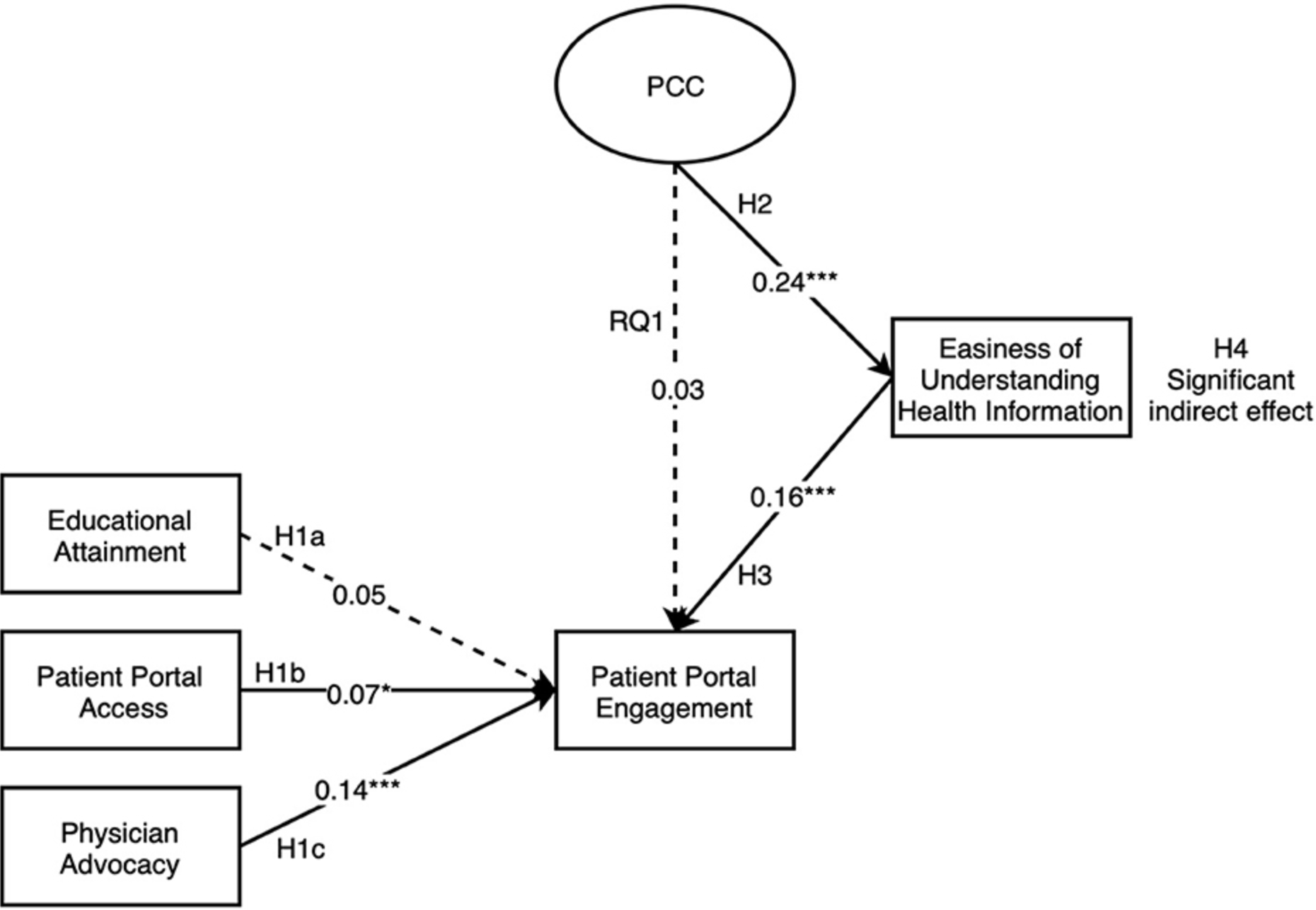 Facilitating Patient Portal Engagement: A Channel Expansion and Behavior Change Wheel PerspectiveWeidan Cao and Xiaohui Cao2024
Facilitating Patient Portal Engagement: A Channel Expansion and Behavior Change Wheel PerspectiveWeidan Cao and Xiaohui Cao2024Given the low patient portal adoption rates, the contradictory findings on the relationship between patient-provider communication and patient portal use, and the unclear mechanism of why doctor-patient communication might facilitate portal use as indicated in some existing studies, patient portal engagement warrants further examination. Guided by the behavior change wheel framework and the channel expansion theory, this study examined the facilitators of patient portal engagement and tested the relationship between the facilitators (e.g., social opportunity and psychological capability) through analyzing the HINTS national survey data (N = 1251). We found that patient portal access (a physical opportunity) and physician advocacy (a social opportunity) were two significant predictors of portal engagement while educational attainment was not. We did not find any direct correlation between patient-centered communication (PCC) and patient portal engagement, but instead, found a significant indirect relationship between the two. To the best of our knowledge, this is the first study to employ the behavior change wheel and channel expansion theory to explain patient portal engagement.Theoretically, our study extended the behavior change theory by further explaining the relationship between the key components (e.g., capability, opportunity) of behavior change.Practical strategies to increase patient portal engagement were proposed.
-
 Effectiveness of Mobile Health for Exercise Promotion on Cardiorespiratory Fitness after a Cancer Diagnosis: A Systematic Review and Meta-AnalysisMegan E. Gregory, Weidan Cao, Saurabh Rahurkar, and 4 more authors2024
Effectiveness of Mobile Health for Exercise Promotion on Cardiorespiratory Fitness after a Cancer Diagnosis: A Systematic Review and Meta-AnalysisMegan E. Gregory, Weidan Cao, Saurabh Rahurkar, and 4 more authors2024Background Cancer survivors are at greater risk for cardiovascular-related mortality. Mobile health (mHealth) is an increasingly prevalent strategy for health promotion, but whether it consistently improves cardiorespiratory outcomes after a cancer diagnosis is unknown. We sought to determine the effectiveness of mHealth fitness/physical activity interventions on cardiorespiratory fitness outcomes among cancer patients and survivors. Methods Leveraging MEDLINE/PubMed, Scopus, and ClinicalTrials.gov, we identified studies through May 2023. Included studies provided a quantitative evaluation of an mHealth intervention in a primary or secondary capacity on cardiorespiratory fitness (6-minute walk test, VO2max, 3-minute step test, or systolic blood pressure; or any mention of cardiac measure) and were meta-analyzed (using a random effects model) if they were a randomized controlled trial with sufficient quantitative information. Four coders were involved in applying inclusion/exclusion criteria, coding using a standardized data extraction sheet, and assessing study quality, with each study coded by at least two. Results Of 656 articles, nine (n = 392) met systematic review inclusion criteria (mean age range 19–62 years, 71.9% female, 60.9% breast cancer). Interventions included mobile apps (k = 6), smartwatches (k = 2), or a smartwatch plus a supplemental web/mobile/tablet app (k = 1); median duration of mHealth-use was 12 weeks. Seven (n = 341) fit criteria for meta-analysis. mHealth was associated with improved cardiorespiratory fitness (d = 0.33; 95% CI = 0.07–0.60) compared to a control group. Relationships remained after accounting for lipid-based outcomes (d = 0.30; 95% CI = 0.03–0.56). There was no evidence for heterogeneity or publication-bias. Conclusions mHealth exercise interventions appear to be a viable strategy for improving cardiorespiratory fitness after a cancer diagnosis.
-
 Clinical Challenges and AI Opportunities in Decision-Making for Cancer Treatment-Induced CardiotoxicitySiyi Wu, Weidan Cao, Shihan Fu, and 7 more authors2024
Clinical Challenges and AI Opportunities in Decision-Making for Cancer Treatment-Induced CardiotoxicitySiyi Wu, Weidan Cao, Shihan Fu, and 7 more authors2024Cardiotoxicity induced by cancer treatment has become a major clinical concern, affecting the long-term survival and quality of life of cancer patients. Effective clinical decision-making, including the detection of cancer treatment-induced cardiotoxicity and the monitoring of associated symptoms, remains a challenging task for clinicians. This study investigates the current practices and needs of clinicians in the clinical decision making of cancer treatment-induced cardiotoxicity and explores the potential of digital health technologies to support this process. Through semi-structured interviews with seven clinical experts, we identify a three-step decision-making paradigm: 1) symptom identification, 2) diagnostic testing and specialist collaboration, and 3) clinical decision-making and intervention. Our findings highlight the difficulties of diagnosing cardiotoxicity (absence of unified protocols and high variability in symptoms) and monitoring patient symptoms (lacking accurate and timely patient self-reported symptoms). The clinicians also expressed their need for effective early detection tools that can integrate remote patient monitoring capabilities. Based on these insights, we discuss the importance of understanding the dynamic nature of clinical workflows, and the design considerations for future digital tools to support cancer-treatment-induced cardiotoxicity decision-making.
-
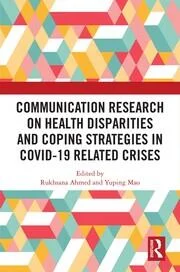 Health Disparities in Online COVID-19 Information Seeking and Protective Behaviors: A Two-Wave Longitudinal StudyQinghua Yang and Weidan CaoIn Communication Research on Health Disparities and Coping Strategies in COVID-19 Related Crises, 2024
Health Disparities in Online COVID-19 Information Seeking and Protective Behaviors: A Two-Wave Longitudinal StudyQinghua Yang and Weidan CaoIn Communication Research on Health Disparities and Coping Strategies in COVID-19 Related Crises, 2024The COVID-19 outbreak was declared a pandemic by the World Health Organization and claimed hundreds of thousands of lives in the U.S. However, the adoption of protective behaviors in response to COVID-19 varies among sociodemographic groups. To better understand the disparities in U.S. adults’ adoption of protective behaviors in relation to sociodemographic factors, we conducted a two-wave panel survey in the U.S. Although sociodemographic factors were not found to be significant predictors in lagged regression analysis, results from a cross-sectional analysis showed that the White, younger, and higher educated individuals were more likely to take protective behaviors. Furthermore, based on the structural equation modeling, indirect effects were observed. Specifically, online COVID-19 information seeking mediated the effects of age and education on performance of protective behaviors, and subjective norms and online COVID-19 information seeking were found to be significant serial mediators of these relationships. The study not only extends the health disparities and health information seeking literature, but also offers practical insights to health campaigns and interventions promoting protective behaviors during a pandemic and reducing health disparities.
2023
-
 A Mobile Health Application for Patients Eligible for Statin Therapy: App Development and Qualitative Feedback on Design and UsabilityWeidan Cao, Lang Li, Puneet Mathur, and 2 more authors2023
A Mobile Health Application for Patients Eligible for Statin Therapy: App Development and Qualitative Feedback on Design and UsabilityWeidan Cao, Lang Li, Puneet Mathur, and 2 more authors2023Cardiovascular disease is the leading cause of death in the United States (US). Despite the well-recognized efficacy of statins, statin discontinuation rates remain high. Statin intolerance is a major cause of statin discontinuation. To accurately diagnose statin intolerance, healthcare professionals must distinguish between statin-associated and non-statin-associated muscle symptoms, because many muscle symptoms can be unrelated to statin therapy. Patients’ feedback on muscle-related symptoms would help providers make decisions about statin treatment. Given the potential benefits and feasibility of existing apps for cardiovascular disease (CVD) management and the unmet need for an app specifically addressing statin intolerance management, the objectives of the study were 1) to describe the developmental process of a novel app designed for patients who are eligible for statin therapy to lower the risk of CVD; 2) to explore healthcare providers’ feedback of the app; and 3) to explore patients’ app usage experience.
-
 Understanding Information Processing and Protective Behaviors during the Pandemic: A Three-Wave Longitudinal StudyWeidan Cao, Qinghua Yang, and Xinyao Zhang2023
Understanding Information Processing and Protective Behaviors during the Pandemic: A Three-Wave Longitudinal StudyWeidan Cao, Qinghua Yang, and Xinyao Zhang2023Background: Few existing studies have examined information processing as an independent variable to predict subsequent information behaviors in a pandemic context, and the mechanism of subsequent information behavior processing following the initial or prior information behavior is unclear. Objective: Our study aims to apply the risk information seeking and processing model to explain the mechanism of subsequent systematic information processing in the context of the COVID-19 pandemic. Methods: A three-wave longitudinal online national survey was administered during the period of July 2020 to September 2020. Path analysis was conducted to test the relationships between prior and subsequent systematic information processing and protective behaviors. Results: One important finding was the key role of prior systematic information processing, as indirect hazard experience was found to be a direct predictor of risk perception (β = 0.15, p = 0.004) and an indirect predictor of protective behaviors. Another important finding was the central role of information insufficiency as a mediator/driving force in subsequent systematic information processing and protective behavior. Conclusions: The study has made important contributions in that it extends the scholarship on health information behaviors by (a) highlighting that relevant hazard experience in risk information seeking and processing model should be expanded to include indirect experience, and (b) providing the mechanism of subsequent systematic information processing following prior information processing. Our study also provides practical implications on health/risk communication and protective behaviors’ promotion in the pandemic context.
-
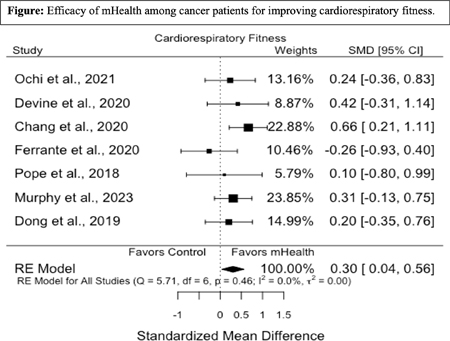 Abstract 19055: Effectiveness of Mobile Health Applications for Exercise Promotion on Cardiorespiratory Fitness After a Cancer Diagnosis: A Systematic Review and Meta-AnalysisSanam M Ghazi, James C Stock, Weidan Cao, and 3 more authors2023
Abstract 19055: Effectiveness of Mobile Health Applications for Exercise Promotion on Cardiorespiratory Fitness After a Cancer Diagnosis: A Systematic Review and Meta-AnalysisSanam M Ghazi, James C Stock, Weidan Cao, and 3 more authors2023Introduction: Cancer survivors are at higher risk for cardiovascular (CV) related mortality. Smartphone application based (app-based) interventions that promote exercise and physical activity are an increasingly prevalent strategy for health promotion. Yet, whether these mobile health (mHealth) interventions improve CV risk after a cancer diagnosis is unknown.Methods: Leveraging MEDLINE/PubMed, Scopus, and Clinical Trials.gov, we identified studies through May 1, 2023. Literature searches were conducted on articles meeting study inclusion criteria and with reported cancer diagnoses. Search terms included smartphone, mobile health, mHealth, app, mobile application, exercise, cancer and cardio-oncology. The main outcomes and measures included change in cardiovascular fitness, reflected by 6-minute walk test (6MWT), VO2max, 3-minute step test and systolic blood pressure or any mention of cardiac measures. Effect sizes were calculated as Cohen’s d. Aggregate effect sizes and moderator variables were tested using random effects models.Results: Overall, from 656 articles, 7 randomized controlled trials (RCTs) with 341 participants were identified. Interventions included mobile apps (n = 6), smartwatches (n = 2), or smartwatch plus an option to also use a web, mobile, or tablet app (n = 1); median age 49.71± 5.9 years; median duration of mHealth use 12 weeks. Across the 7 RCTs, mHealth was associated with improved cardiorespiratory outcomes (Cohen’s d=0.33; 95% CI, 0.07-0.60). Results maintained significance when cholesterol outcomes were added to the other cardiorespiratory outcomes (d = 0.30; 95% CI = 0.03-0.56). There was no heterogeneity (Q = 5.86, P >0.05) or publication bias (P > .05). Among the 4 studies examining the 6MWT, the between groups Δ Cohen’s d was 0.27 (95% CI, -0.21, 0.75).Conclusions: Smartphone app-based exercise promotion interventions appear to be a viable strategy for improving cardiorespiratory fitness after a cancer diagnosis.
-
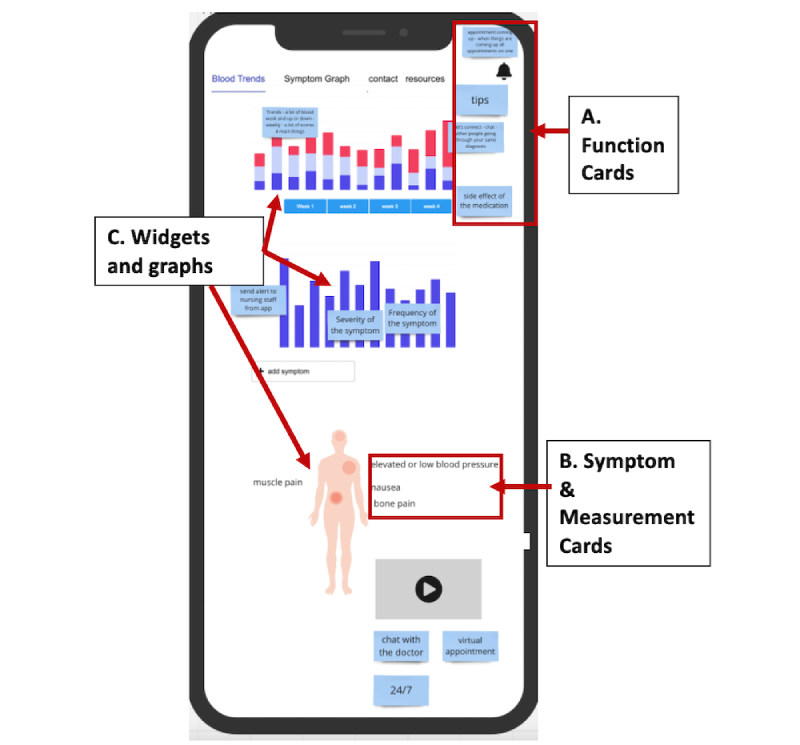 Exploring the Incorporation of a Novel Cardiotoxicity Mobile Health App Into Care of Patients With Cancer: Qualitative Study of Patient and Provider PerspectivesMegan E. Gregory, Weidan Cao, Saurabh Rahurkar, and 8 more authors2023
Exploring the Incorporation of a Novel Cardiotoxicity Mobile Health App Into Care of Patients With Cancer: Qualitative Study of Patient and Provider PerspectivesMegan E. Gregory, Weidan Cao, Saurabh Rahurkar, and 8 more authors2023Background: Cardiotoxicity is a limitation of several cancer therapies and early recognition improves outcomes. Symptom-tracking mobile health (mHealth) apps are feasible and beneficial, but key elements for mHealth symptom-tracking to indicate early signs of cardiotoxicity are unknown. Objective: We explored considerations for the design of, and implementation into a large academic medical center, an mHealth symptom-tracking tool for early recognition of cardiotoxicity in patients with cancer after cancer therapy initiation. Methods: We conducted semistructured interviews of >50% of the providers (oncologists, cardio-oncologists, and radiation oncologists) who manage cancer treatment-related cardiotoxicity in the participating institution (n=11), and either interviews or co-design or both with 6 patients. Data were coded and analyzed using thematic analysis. Results: Providers indicated that there was no existing process to enable early recognition of cardiotoxicity and felt the app could reduce delays in diagnosis and lead to better patient outcomes. Signs and symptoms providers recommended for tracking included chest pain or tightness, shortness of breath, heart racing or palpitations, syncope, lightheadedness, edema, and excessive fatigue. Implementation barriers included determining who would receive symptom reports, ensuring all members of the patient’s care team (eg, oncologist, cardiologist, and primary care) were informed of the symptom reports and could collaborate on care plans, and how to best integrate the app data into the electronic health record. Patients (n=6, 100%) agreed that the app would be useful for enhanced symptom capture and education and indicated willingness to use it. Conclusions: Providers and patients agree that a patient-facing, cancer treatment-related cardiotoxicity symptom-tracking mHealth app would be beneficial. Additional studies evaluating the role of mHealth as a potential strategy for targeted early cardioprotective therapy initiation are needed.
-
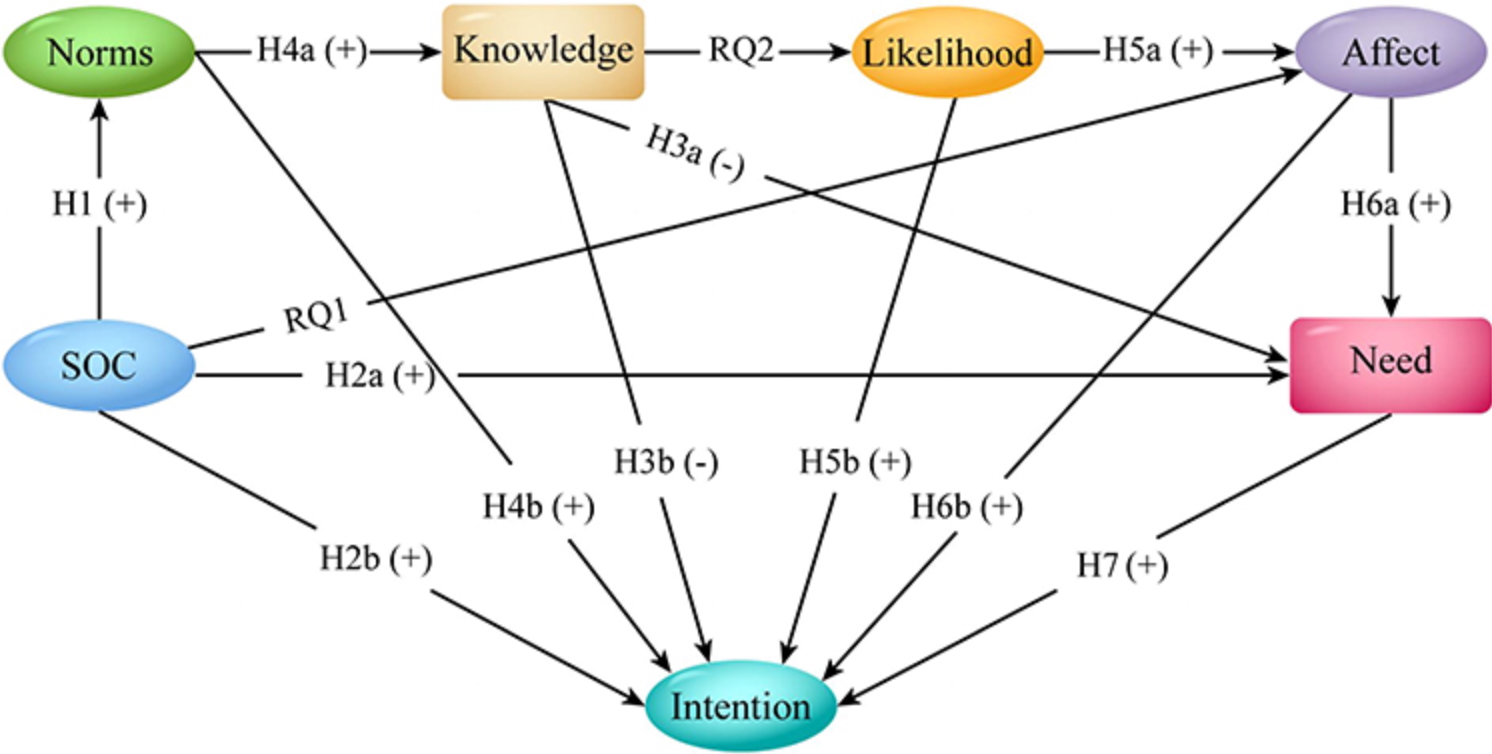 Analysis of the Influencing Factors of Seeking Intention on COVID-19 Risk Information: A Cross-Sectional StudyNan Li, Wei-Xin Zhang, Yan-Yan Sun, and 4 more authors2023
Analysis of the Influencing Factors of Seeking Intention on COVID-19 Risk Information: A Cross-Sectional StudyNan Li, Wei-Xin Zhang, Yan-Yan Sun, and 4 more authors2023 -
 Human-Centered Design and Evaluation of AI-empowered Clinical Decision Support Systems: A Systematic ReviewLiuping Wang, Zhan Zhang, Dakuo Wang, and 6 more authors2023
Human-Centered Design and Evaluation of AI-empowered Clinical Decision Support Systems: A Systematic ReviewLiuping Wang, Zhan Zhang, Dakuo Wang, and 6 more authors2023Artificial intelligence (AI) technologies are increasingly applied to empower clinical decision support systems (CDSS), providing patient-specific recommendations to improve clinical work. Equally important to technical advancement is human, social, and contextual factors that impact the successful implementation and user adoption of AI-empowered CDSS. With the growing interest in human-centered design and evaluation of such tools, it is critical to synthesize the knowledge and experiences reported in prior work and shed light on future work. To that end, we conducted a systematic review to gain an in-depth understanding of how AI-empowered CDSS was used, designed, and evaluated, and how clinician users perceived such systems. Our findings highlighted six major challenges, including technical limitations, workflow misalignment, attitudinal barriers, informational barriers, usability issues, and environmental barriers. These sociotechnical challenges prevent the effective use of AI-based CDSS interventions in clinical settings. We further discuss design implications and future research directions.
2022
-
 mHealth Interventions for Self-management of Hypertension: Framework and Systematic Review on Engagement, Interactivity, and TailoringWeidan Cao, M. Wesley Milks, Xiaofu Liu, and 4 more authors2022
mHealth Interventions for Self-management of Hypertension: Framework and Systematic Review on Engagement, Interactivity, and TailoringWeidan Cao, M. Wesley Milks, Xiaofu Liu, and 4 more authors2022Background: Engagement is essential for the effectiveness of digital behavior change interventions. Existing systematic reviews examining hypertension self-management interventions via mobile apps have primarily focused on intervention efficacy and app usability. Engagement in the prevention or management of hypertension is largely unknown. Objective: This systematic review explores the definition and role of engagement in hypertension-focused mobile health (mHealth) interventions, as well as how determinants of engagement (ie, tailoring and interactivity) have been implemented. Methods: A systematic review of mobile app interventions for hypertension self-management targeting adults, published from 2013 to 2020, was conducted. A total of 21 studies were included in this systematic review. Results: The engagement was defined or operationalized as a microlevel concept, operationalized as interaction with the interventions (ie, frequency of engagement, time or duration of engagement with the program, and intensity of engagement). For all 3 studies that tested the relationship, increased engagement was associated with better biomedical outcomes (eg, blood pressure change). Interactivity was limited in digital behavior change interventions, as only 7 studies provided 2-way communication between users and a health care professional, and 9 studies provided 1-way communication in possible critical conditions; that is, when abnormal blood pressure values were recorded, users or health care professionals were notified. The tailoring of interventions varied at different aspects, from the tailoring of intervention content (including goals, patient education, advice and feedback from health professionals, reminders, and motivational messages) to the tailoring of intervention dose and communication mode. Tailoring was carried out in a number of ways, considering patient characteristics such as goals, preferences, disease characteristics (eg, hypertension stage and medication list), disease self-management experience levels, medication adherence rate, and values and beliefs. Conclusions: Available studies support the importance of engagement in intervention effectiveness as well as the essential roles of patient factors in tailoring, interactivity, and engagement. A patient-centered engagement framework for hypertension self-management using mHealth technology is proposed here, with the intent of facilitating intervention design and disease self-management using mHealth technology.
-
 A Pharmacovigilance Study of Pharmacokinetic Drug Interactions Using a Translational Informatics Discovery ApproachLei Wang, Aditi Shendre, Chien-Wei Chiang, and 5 more authors2022
A Pharmacovigilance Study of Pharmacokinetic Drug Interactions Using a Translational Informatics Discovery ApproachLei Wang, Aditi Shendre, Chien-Wei Chiang, and 5 more authors2022Background While the pharmacokinetic (PK) mechanisms for many drug interactions (DDIs) have been established, pharmacovigilance studies related to these PK DDIs are limited. Using a large surveillance database, a translational informatics approach can systematically screen adverse drug events (ADEs) for many DDIs with known PK mechanisms. Methods We collected a set of substrates and inhibitors related to the cytochrome P450 (CYP) isoforms, as recommended by the United States Food and Drug Administration (FDA) and Drug Interactions Flockhart table™. The FDA’s Adverse Events Reporting System (FAERS) was used to obtain ADE reports from 2004 to 2018. The substrate and inhibitor information were used to form PK DDI pairs for each of the CYP isoforms and Medical Dictionary for Regulatory Activities (MedDRA) preferred terms used for ADEs in FAERS. A shrinkage observed-to-expected ratio (Ω) analysis was performed to screen for potential PK DDI and ADE associations. Results We identified 149 CYP substrates and 62 CYP inhibitors from the FDA and Flockhart tables. Using FAERS data, only those DDI-ADE associations were considered that met the disproportionality threshold of Ω > 0 for a CYP substrate when paired with at least two inhibitors. In total, 590 ADEs were associated with 2085 PK DDI pairs and 38 individual substrates, with ADEs overlapping across different CYP substrates. More importantly, we were able to find clinical and experimental evidence for the paclitaxel-clopidogrel interaction associated with peripheral neuropathy in our study. Conclusion In this study, we utilized a translational informatics approach to discover potentially novel CYP-related substrate-inhibitor and ADE associations using FAERS. Future clinical, population-based and experimental studies are needed to confirm our findings.